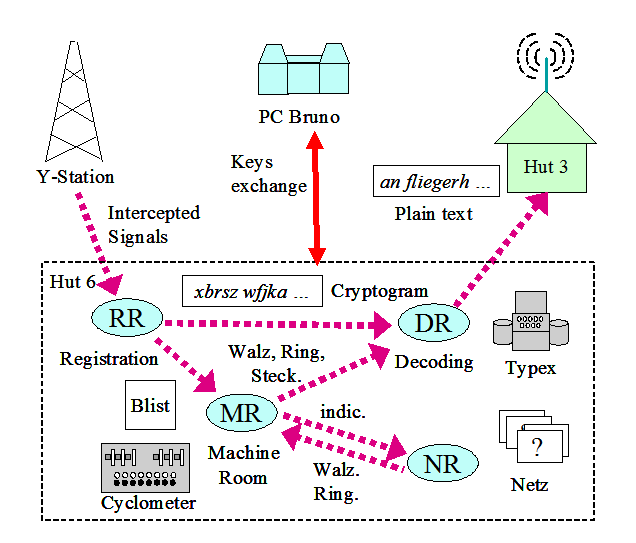Birth of HUT 6

Introduction
From November 1939, during the production of the Zyglaski sheets, Gordon Welchman created on Paper Hut 6, that is to say the operational organization which must decipher the Enigma messages of the army and the army of the air. His proposal is accepted. From January 1940, Hut 6 takes shape and decryption begins.
The War
The War started with Germany's invasion of Poland on 1 September 1939. On 5 October, the Poland surrender.
Despite the quick campaign in the east, along the Franco-German frontier the war settled into a quiet period. This relatively non-confrontational and mostly non-fighting period between the major powers lasted until 10 May 1940, and was known as the Phoney War.
The Norwegian Campaign occurred on 9 April-10 June 1940 during World War II. Nazi Germany invaded Norway to prevent Britain and France from occupying the country's ports, and the French and British sent an expeditionary force to assist the Norwegians. Despite moderate successes in northern Norway, the Allied Powers were ultimately compelled to withdraw.
The Keys
At the start of the war, the allies intercept (and partially decipher) three keys:
- Red: Air force
- Green: The army
- Blue: an air-force training network.
Organization
Although the sheets would not be put into operation until January, Welchman had the intuition in mid-November 1939 that a considerable mass of deciphering would follow and would require a multitude of staff working within an organization strictly dissociated from the office of Knox and Turing, who would then be relegated to research work. His proposal was accepted, and Hut 6 was born. Here was its structure:
- Registration Room (RR):
It received messages from the radio interception centers (Y-Stations) and recorded them in a "Blist" containing all the data useful for breaking keys. When a key was broken, it transmitted the complete intercepted messages to the DR.
- Machine Room (MR):
It prepared the data from the Blist used by the NR, checked its results and completed the keys (it found the Steckervinbindung).
- Netz Room (NR):
It used the sheets to find the Walzenlage and the Ringstellung.
- Decoding Room (DR):
It decrypted the messages associated with the keys that had been broken. It then transmitted plain texts to the SIS (Intelligence Service) for translation and exploitation.
The MR used Blists to identify messages belonging to the same network. Then, it extracted the Grundstellung associated with indicators comprising females which were the basis for using the sheets. It sent the resulting menus to the NR. It kept the indicators and, then, found the Steckers when a plausible key was found by the NR. For that, it used the Cyclometers.
Unlike France, the English did not need to make Enigma to decipher the messages. The RAF used the Type-X (or Typex) cipher machine, which derives directly from the commercial Enigma and several of which were quickly transformed to emulate the Enigma. On November 1, the team of the future Hut 6 (which would not move in until January 1940) had enough Type-X (National Archives HW 14/2).
The SIS occupied Hut 3, right next to Hut 6. At the beginning, it would only deal with translating the messages and transmitting them to Whitehall. It was comprised of only three people, led by Lt. Commander Malcom Saunders (one of the three; the other two being S.C. Edgar and F.L. Lucas).
It was at the end of January that the English cryptologists who managed the Enigma of the army and the air force moved into Hut 6. At that time, the traffic was light, so there was no need for a night shift, and anyway, there were not enough staff to provide it. Therefore, there were only two successive teams per day.
Staff
As BP organized itself, active recruitment was carried out by acquaintances (a former pupil), or by acquaintances of acquaintances (a pupil of a colleague). Before the end of March 1940, thanks to Welchman, Jeffreys and Edward Travis (Denniston's assistant), the following people arrived at BP as apprentice cryptologists in charge of Enigma decryption in Hut 6: Stuart Milner-Barry, Hugh Alexander, Harold Fletcher, Houston Wallace, Dennis Babbage, David Rees, John Herivel, John Chamberlain, Howard Smith, John Manisty, Alexander Aitken, David Gaunt and John Colman. In addition, dozens of typists, most of them women, were hired.
Equipment
The main equipment was Zygalski’s sheets (Netz). Cyclometers made it possible to test a solution. Typex were used to emulate Enigma to decipher messages.